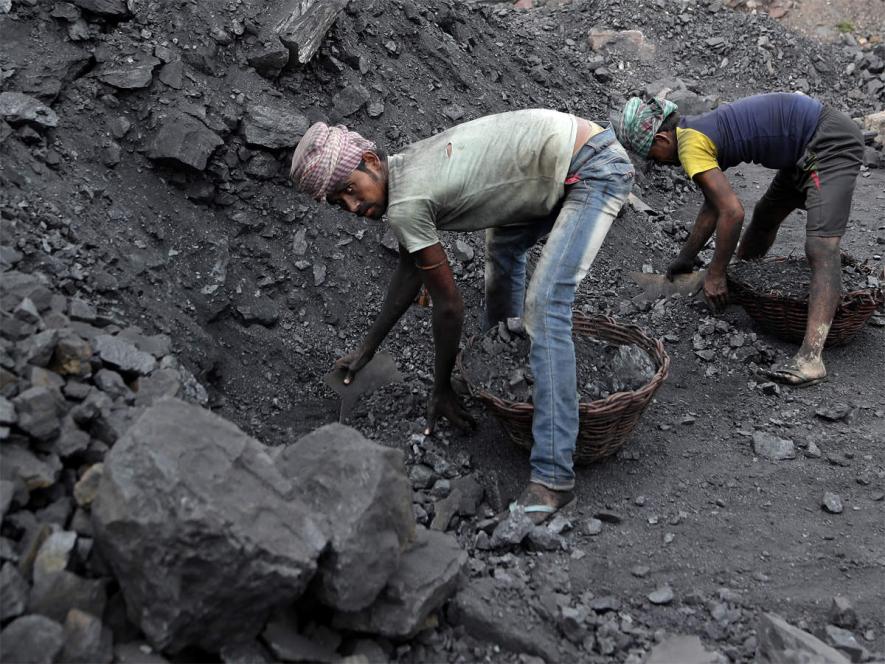Commercialisation of Coal Mining Can’t Lead to Minimising of Imports as Govt Claims

Image Courtesy: The Economic Times
The Government of India (GoI) through a notification on June 18, 2020, officially opened the Indian coal mining sector to commercial operations by private industry. Coal extracted from mines identified for auction under the process can now be freely utilised either for captive consumption or for sale, including export. Prior to this, industries were subjected to end-use restrictions.
Launched under the “Atmanirbhar Bharat Abhiyan”, the stated aim of the move is to “enable the country achieve self-sufficiency in meeting its energy needs and boost industrial development”. The GoI claims that this would enable the generation of capital investments in India amounting to Rs 33,000 crore over the next 5-7 years and the concomitant creation of over 2.8 lakh direct and indirect jobs.
Notably, this comes on the back of a decision by the Union Cabinet on August 28, 2019, allowing 100% FDI for coal mining under the automatic route. With the electronic auctions of coal mines scheduled to end on November 11, 2020, it is imperative that the process' supposed transformative potential is subjected to an objective analysis.
India imported, as per provisional figures by the Ministry of Coal, a total of 248.54 Million Tonnes (MT) of coal in 2019-20. Of this, non-coking coal was 196.71 MT whereas coking coal constituted 51.83 MT. On the face of it, this may seem to lend credence to Prime Minister Modi’s argument on the absurdity of India’s coal imports situation—“it is ironic that India, with the world’s fourth largest coal reserve and being the second largest producer, is also the second largest coal importer.”
This is especially so, since non-coking coal constitutes 89.3% (as on April 1, 2019) of India’s proved reserves of coal. It is to be noted however that, in keeping with past trends, over 50% of India’s non-coking coal imports in 2019 were of high-quality coal. Given that India has an abundance of relatively low-grade non-coking coal, there exists little scope for the substitution of India’s existing requirements by domestic production of the same. Same is the case with coking coal, with the low-ash coking coal that finds usage in the production of steel not being found in abundance in India. Furthermore, this quality has not shown any improvement over the years; rather, data indicates that the quality of Indian coal has seen a start decline over the last nearly 20 years.
Therefore, considering that India’s structural requirements for high-quality coal will only increase in the future, it remains unlikely that future requirements of the same can be met adequately without imports. The above conclusion is further bolstered by the fact that nearly 90% of India's coal-fired thermal power plants that are currently being constructed would employ the use of supercritical or ultrasupercritical technology that would be incompatible with low-quality domestic coal. This therefore would further intensify India's reliance on imported coal.
Also read: Govt Extends Mining Reform Consultations by a Week as Criticism Mounts
More importantly, it must also be stated that projected growth in demand for indigenous coal can be fulfilled by coal mines that have been already auctioned or allocated. Coal India Limited’s Coal Vision 2030 document states in this regard, “The total capacity of mines allocated/ auctioned (including to CIL, SCCL and NLCIL) as on date is about 1,500 MTPA at the current rated capacity. In view of the likely demand (base case scenario), there is limited requirement of starting new coal mines except the ones already auctioned/ allocated.” Additionally, the 37th Report of The Standing Committee on Energy has gone on to note: “Ministry of Coal has stated...that CIL had adequate availability of coal and coal stock to meet the requirement of Power Sector.”
It is to be noted that multiple coal blocks to be auctioned are situated in areas that have been identified as "High Conservation Zones", many being concomitantly situated in areas that are inhabited by Adivasi settlements. The assertion by the GoI that this exercise would lead to the generation of over 2.8 lakh jobs is also to be contextualised and questioned in this regard.
A majority of mines would employ opencast mining—involving a higher degree of mechanisation that is labour-throwing in nature as opposed to underground mining which is labour-intensive. The year-end manpower statistics for CIL in this regard is illustrative, with the number of employees seeing a drastic reduction from nearly 4 lakh in 2010, to under 3 lakh in 2019. Furthermore, it remains to be seen what would be the nature of these jobs. The vast majority of new jobs that would be created are by the GoI’s own admission, indirect jobs.
A cursory perusal of trends in coal mining employment in India reveals the extent to which this implies the exploitation of dispossessed local communities that are forced to eke out a living in the midst of a changing socio-economic scenario. Millions of households are thus dependent in the coal-belt region upon either contract or subsistence mining with little to no hope of job security.
With an increase in the uptake of mechanisation, India thus presents an opportunity for industry to capitalise on an increasingly cheaper labour force by forcing a race to the bottom. A study sponsored by the NITI Aayog itself in this regard has gone on to state: “The intervention of mining has posed a serious question on sustainable livelihoods. People now depend on mining and allied areas for their survival but issue at hand is what will happen once the mining activities are over in these areas?”
The report goes on to note changes in societal relations due to the introduction of mining in forest-dependent communities including: an increase in the preponderance of criminal activities, uptake in alcoholism, a perceivable shift to a class-divided society from a largely egalitarian one, and a general breakdown of village life.
Also read: Adani Foists Coal Mines and Hinduism on Communities
It can be concluded therefore that this move, while will undeniably lead to the dispossession and exploitation of forest-dependent communities, cannot lead to the achievement of the stated aim of minimising imports. Given the reality of globalisation today whereby the availability of cheap resources is of utmost importance for the sustenance of the system of capitalist production, the opening of the Indian coal mining sector to commercial exploitation needs to be situated within the process of resource expropriation from the Global South.
This necessarily strengthens the argument that it is but an attempt to enable capital to tide over the increasingly intensifying barriers to accumulation it is faced with, by opening up newer avenues to stimulate investments. Given the pessimism over the future of coal owing to reasons including but not limited to: constrained economic growth projections for India and the world, the NPA crisis that has come to characterise power generation and steel industries, and the uptake in solar and other renewable energy sources in India’s energy matrix, it remains unlikely that any additional increase in capacity can occur in the absence of significant interventions from the GoI on behalf of private industry. The increasing attempts by the GoI to loosen environmental regulations amid record levels of disinvestment is also to be situated in this context.
(The author is a Research Associate at the Social and Political Research Foundation. Views expressed are personal)
Get the latest reports & analysis with people's perspective on Protests, movements & deep analytical videos, discussions of the current affairs in your Telegram app. Subscribe to NewsClick's Telegram channel & get Real-Time updates on stories, as they get published on our website.
























